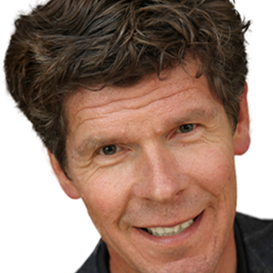Jennifer Overbury
Smart project management in a technical domain
There’s more to ITEA than technology: as the leader of the ITEA project SMART, Jennifer Overbury recently demonstrated the balance that an experienced manager can provide between the overarching objectives and technical nitty gritty. “You know, technical minds can sometimes get down rabbit holes when there’s cool technology. But we need to delicately steer that energy towards the project goals. Bringing that experience to the project can be a beneficial contribution – it doesn’t have to be 100% technical.”

Intelligent questions
That’s not to say that Jennifer is nontechnical. Having been interested in the physical world since childhood, she majored in Geography at the University of Calgary and joined geographic information systems (GIS) company Esri Canada in the 1980s. “GIS was a really new technology and, when I turned up at Esri Canada to be interviewed, it was a little bit embarrassing because the owner had to explain to me what GIS was and how it was going to change the technology world,” Jennifer recalls. “I think I got hired on the basis of asking some intelligent questions and showing my sincere enthusiasm for anything geographic; there weren’t a lot of GIS professionals floating around at the time.”
Long overdue
Over time, Jennifer’s role within the company shifted to managing professional services engagements and, after 13 years, she opted to experience the client side of work at a large Canadian bank. There, she received formal project management training and attained her project management professional designation. The roots of her international project leadership ultimately go back to an assignment received during that first 13 years at Esri Canada.
“Back in 1993, Esri Canada participated in a GIS implementation project for a regional water agency in Cairo. I was very fortunate to be sent to Egypt and work for two weeks with local water engineers to help them deploy GIS on a mainframe with command line software that wasn’t easy to teach or learn. I guess I was due to work on another project outside my home country – and then this ITEA one came along.”
The Science of Where
The ITEA project in question was SMART, which brought together partners in Canada and the Netherlands to investigate dynamic traffic control and geospatial visualisation in cities. This appealed to Jennifer not only for its focus on GIS but for the demonstrable societal value. “I’ve lived in the large city of Toronto my whole life, so I was very interested in moving the dial towards solutions for congestion,” she says. “And we geographers see everything through ‘The Science of Where’, which is actually an Esri slogan. Where is the traffic congestion? Where are the emergency vehicles being routed? Where is the transportation infrastructure? The problem set of the project made a lot of sense to me. I came to it not with technical wizardry but with years of project management experience. At the high level, that role is to orchestrate all the technical geniuses in their work. So, you clear the roadblocks, you help with the decisions, and you provide guidance to ensure all our efforts are aimed at the objectives and the goals of the project.”
Kindness and patience
I’m all for encouraging women to get alongside the men in these big projects. If my story encourages even one other woman to lead an ITEA project, that would be another positive outcome of the project.
These skills were especially pertinent as Jennifer stepped into the project after the previous leader’s retirement, requiring her to catch up on six months of progress while contending with a six-hour time difference and the COVID-19 lockdowns. With so much global uncertainty, the project cooperation agreement was still to be signed and one of Jennifer’s first tasks was to focus the consortium on this unappealing administrative task so that the more enjoyable technical elements could take flight. “Among those consortium members, there were two former project leaders, Egbert and Egor, who stepped in to get me up to speed,” Jennifer continues. “I also had a point person from the ITEA Office, Özgün, who has been a saviour. I quickly got the sense that this was going to be a project full of meaningful collaboration and that we would form a really fun and positive team.”
“It was also interesting because I was the only woman on the project as well as the least technical. It was scary at first, but people were kind and generous with their patience. I see and feel the equality in the workplace. However, women of a certain demographic may harbour reservations from previous decades. If you push that thinking aside and step into an ITEA leader role, I think you will find it incredibly rewarding and have a lot of fun too! I’m all for encouraging women to get alongside the men in these big projects. If my story encourages even one other woman to lead an ITEA project, that would be another positive outcome for the project.”
Planting a seed
Once the project was in full swing, Jennifer’s overriding emotion was excitement. Prior to SMART, she had never worked so closely in bridging the gap between research at universities and applications in industry. “At universities, leading-edge ideas and technology are in their infancy. In an ITEA project, we have to try and find out what gets a foothold in industry and push the envelope,” Jennifer explains. “I’d never seen that in action. It’s one of the most important features of these projects: a seed gets planted and, at the end, it’s a walking, talking toddler – or at least a minimum viable product integrated with practical industry solutions. Having these unlikely partners come together with so many different ideas and technologies is invaluable. Coming into the project, all the consortium members had their own successful businesses and solutions. But as Aristotle said, the whole is greater than the sum of its parts. And it couldn’t have been truer for this SMART project.”
Thinking, innovating, collaborating
“To me personally, it brought a huge sense of accomplishment to achieve a project of this magnitude and calibre and to be a part of such a special group of people and technologies is memorable. I feel like I contributed by helping everyone meet their goals with their technology.” Jennifer smiles. “To ITEA I’d like to say: you are bold thinkers, innovators and collaborators – continue the trajectory, send it to the moon and keep doing what you are doing. Working with ITEA was nothing short of excellent: they want you to succeed and they’re incredibly helpful. The support I received as a first-time ITEA project leader was just amazing. My closing thought is there’s an uncommon camaraderie within the project that I’ll keep with me until I’m in my rocking chair.”
Other chapters
Use the arrows to view more chapters

Editorial
By Jan Jonker

Country Focus: Austria
Tapping into innovative potential and using new knowledge for market growth

IT-V Medizintechnik
Achieving a better position in international innovation

ITEA Success story: PIANiSM
Pioneering predictive maintenance for a smarter future in manufacturing

Advancing gender equality in innovation
Insights for ITEA from Vinnova

ITEA Success story: EMPHYSIS
EMPHYSIS: Bridging the gap between digital simulation and embedded software with eFMI®

Community Talk with Jennifer Overbury
Smart project management in a technical domain

SME in the Spotlight: icometrix
Transforming neuroimaging with AI

End user happiness: Mad@Work
Digital solutions enhancing personal well-being and organisational success

